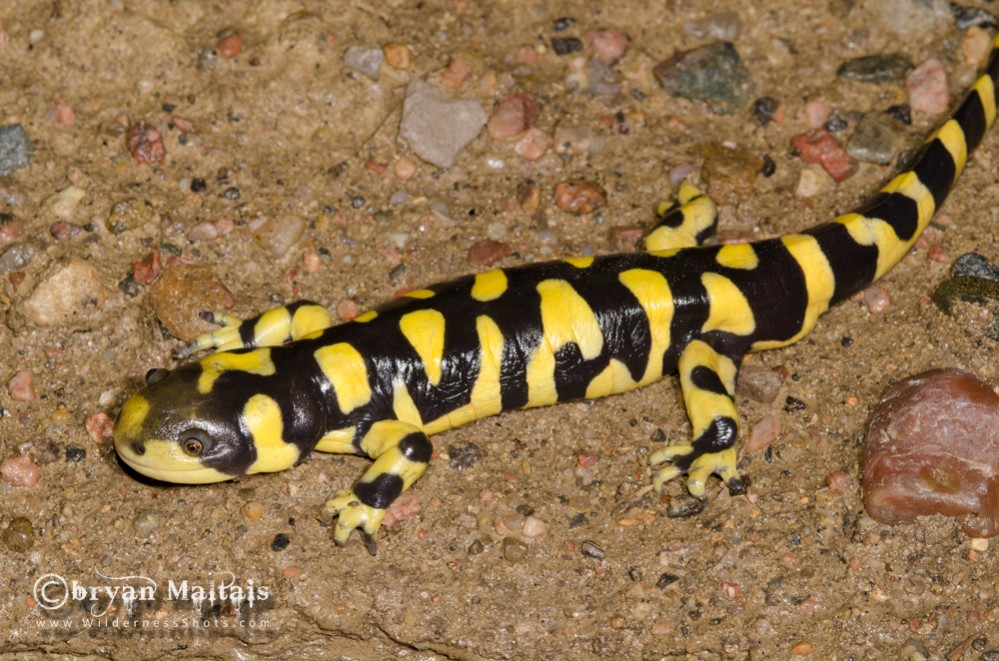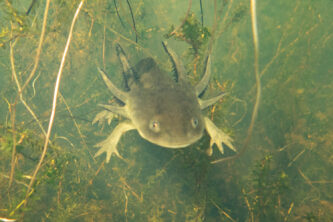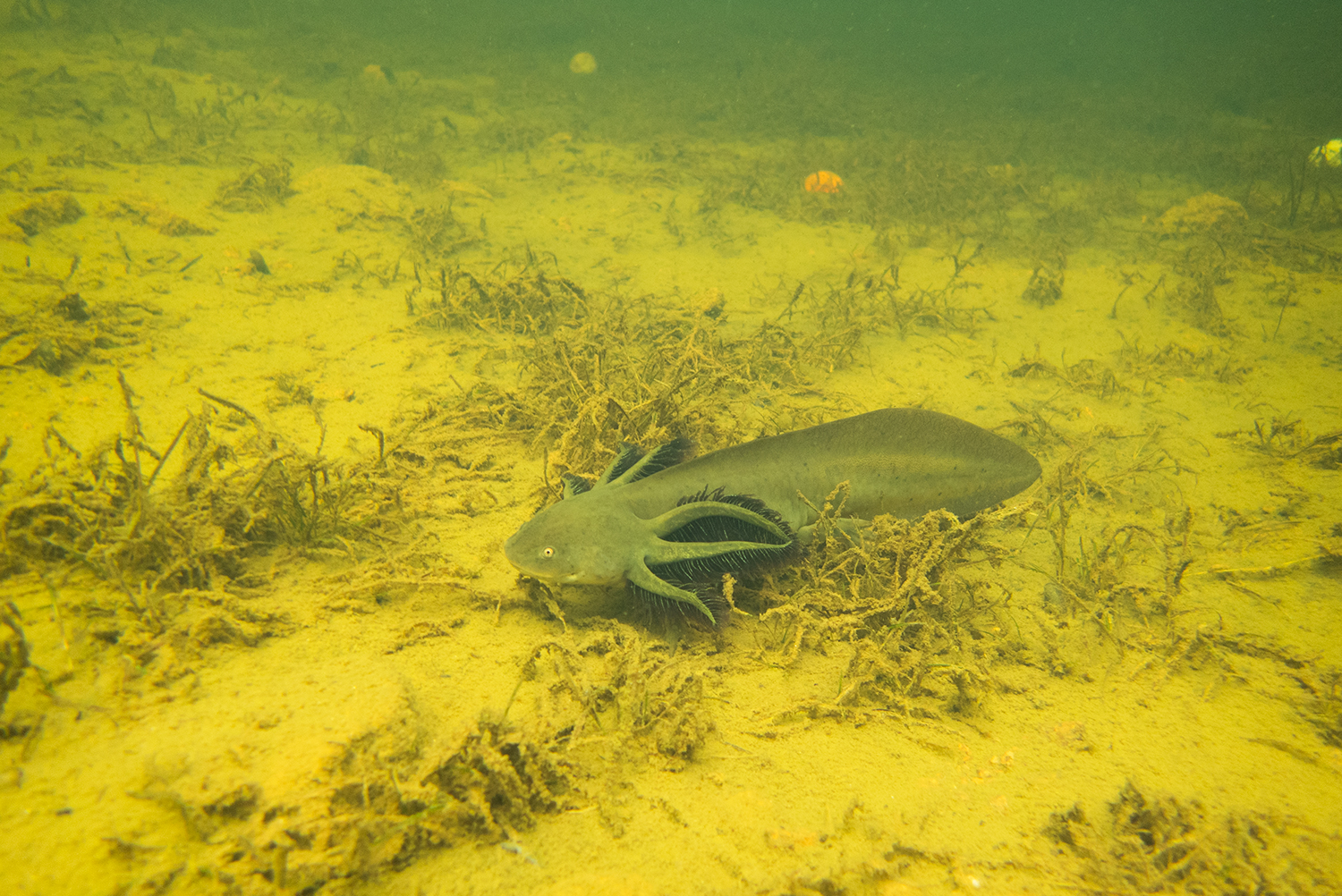
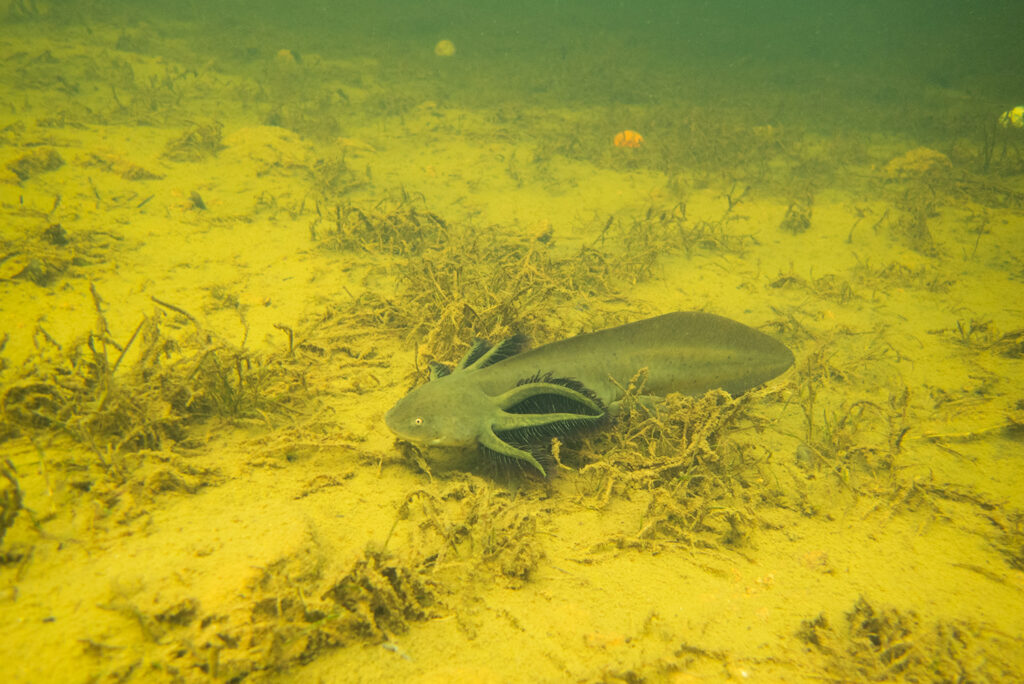 Sometimes truth is stranger than fiction. A friend told me that while playing golf at an (undisclosed) course in the mountains he noticed that the water hazard was full of salamanders. I went to check it out. The pond was in the middle of highly trafficked, manicured greens some distance from the forest on the edge of town where you wouldn’t expect to find salamanders. Sure enough, it was filled with large neotenic Barred Tiger Salamanders (Ambystoma mavortium) and errant golf balls. I photographed the salamanders underwater in their pond with a waterproof camera on the end of a long pole while standing on shore. I had to do it quickly because golfers were trying to play through.
Sometimes truth is stranger than fiction. A friend told me that while playing golf at an (undisclosed) course in the mountains he noticed that the water hazard was full of salamanders. I went to check it out. The pond was in the middle of highly trafficked, manicured greens some distance from the forest on the edge of town where you wouldn’t expect to find salamanders. Sure enough, it was filled with large neotenic Barred Tiger Salamanders (Ambystoma mavortium) and errant golf balls. I photographed the salamanders underwater in their pond with a waterproof camera on the end of a long pole while standing on shore. I had to do it quickly because golfers were trying to play through.
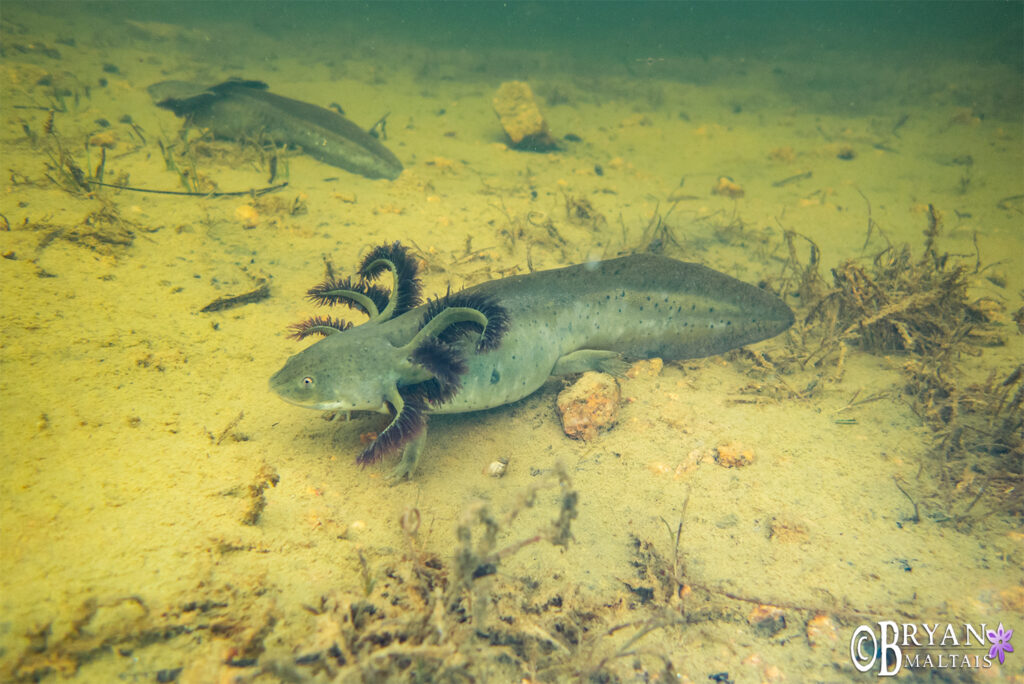 In spring the Tiger Salamander is laid as an egg in water. It then hatches into a gilled, aquatic larva that spends the summer eating and growing. At summer’s end it usually metamorphoses into a land-dwelling salamander that has traded its gills for lungs. In rare circumstances, however, when Tiger Salamanders find a permanent body of water that has no fish, they can become “neotenic”. Neotony is when they remain in their aquatic larval form for their entire lives and don’t metamorphose. They become sexually mature in this larval form and can mate. Because amphibians have indeterminate growth (they never stop growing) and there’s often a constant food supply of aquatic insects, neotenic Tiger Salamanders can become huge 12″ leviathans. Their land-dwelling brethren rarely attain such size because they live in arid environments where the majority of feeding occurs only on a few warm, rainy nights when they come above ground. The rest of the time they lie inactive underground in mammal burrows waiting for the next rain.
In spring the Tiger Salamander is laid as an egg in water. It then hatches into a gilled, aquatic larva that spends the summer eating and growing. At summer’s end it usually metamorphoses into a land-dwelling salamander that has traded its gills for lungs. In rare circumstances, however, when Tiger Salamanders find a permanent body of water that has no fish, they can become “neotenic”. Neotony is when they remain in their aquatic larval form for their entire lives and don’t metamorphose. They become sexually mature in this larval form and can mate. Because amphibians have indeterminate growth (they never stop growing) and there’s often a constant food supply of aquatic insects, neotenic Tiger Salamanders can become huge 12″ leviathans. Their land-dwelling brethren rarely attain such size because they live in arid environments where the majority of feeding occurs only on a few warm, rainy nights when they come above ground. The rest of the time they lie inactive underground in mammal burrows waiting for the next rain.
Aesthetically, neotenic Tiger Salamanders look more like catfish than land-dwelling salamanders of their own species. They’re gray with large feathered gills, a goolishly wide mouth for vacuuming up prey, and a tail that’s been flattened into a huge caudal fin for powerful swimming. Metamorphosed Tiger Salamanders have a body built for land with black and yellow stripes.
- This is what a non-neotenic adult Western Tiger Salamander looks like after metamorphosis.
- Neotenic adult Tiger Salamander
Permanent waters that don’t contain fish are extremely rare because humans insist on stocking them. Fish can also reach water bodies by natural means through flooding or being accidentally transported by animals that move between wetlands. Tiger Salamanders can’t survive with fish because every one of their eggs and larvae are easily gobbled up. People often introduce fish thinking they’re enhancing biodiversity when in reality, it’s a death sentence for most amphibians. Tiger Salamanders can also spawn in ephemeral wetlands that fill with spring rains, and dry up by summer’s end. This drying up prevents fish from becoming established and gives the salamander larvae just enough time to metamorphose.
It seems clear why Tiger Salamanders would trade a harsh terrestrial life for a life aquatic, should they find one without fish. In the water they’re surrounded by sexual mates; there’s no need for an exhausting breeding migration that exposes them to predators and the elements. With constant moisture and food, there’s no dependence on rain to venture out to feed, and no fear of drought. However, we’re not sure what physiological switch triggers neoteny. There’s theory that both the presence of fish and water drying-up somehow stimulates the release of Thyroid Hormone, which is responsible for metamorphosis.
This is the third instance of neotenic Tiger Salamanders that I’ve discovered in Colorado. The first was at an abandoned gravel quarry in Laporte in 2011. The bottom of the quarry had permanent pools that presumably reached the water table and didn’t dry up. The scattered pools surrounded by rocky landscape turned out to be a haven for many reptiles and amphibians. It was close enough to my home that I was able to film the salamanders and their habitat for an entire year and turn it into an award-winning documentary. Unfortunately, the wetland was flooded to make a lake and reportedly stocked with fish. You can still watch the documentary and what this habitat once was here:

